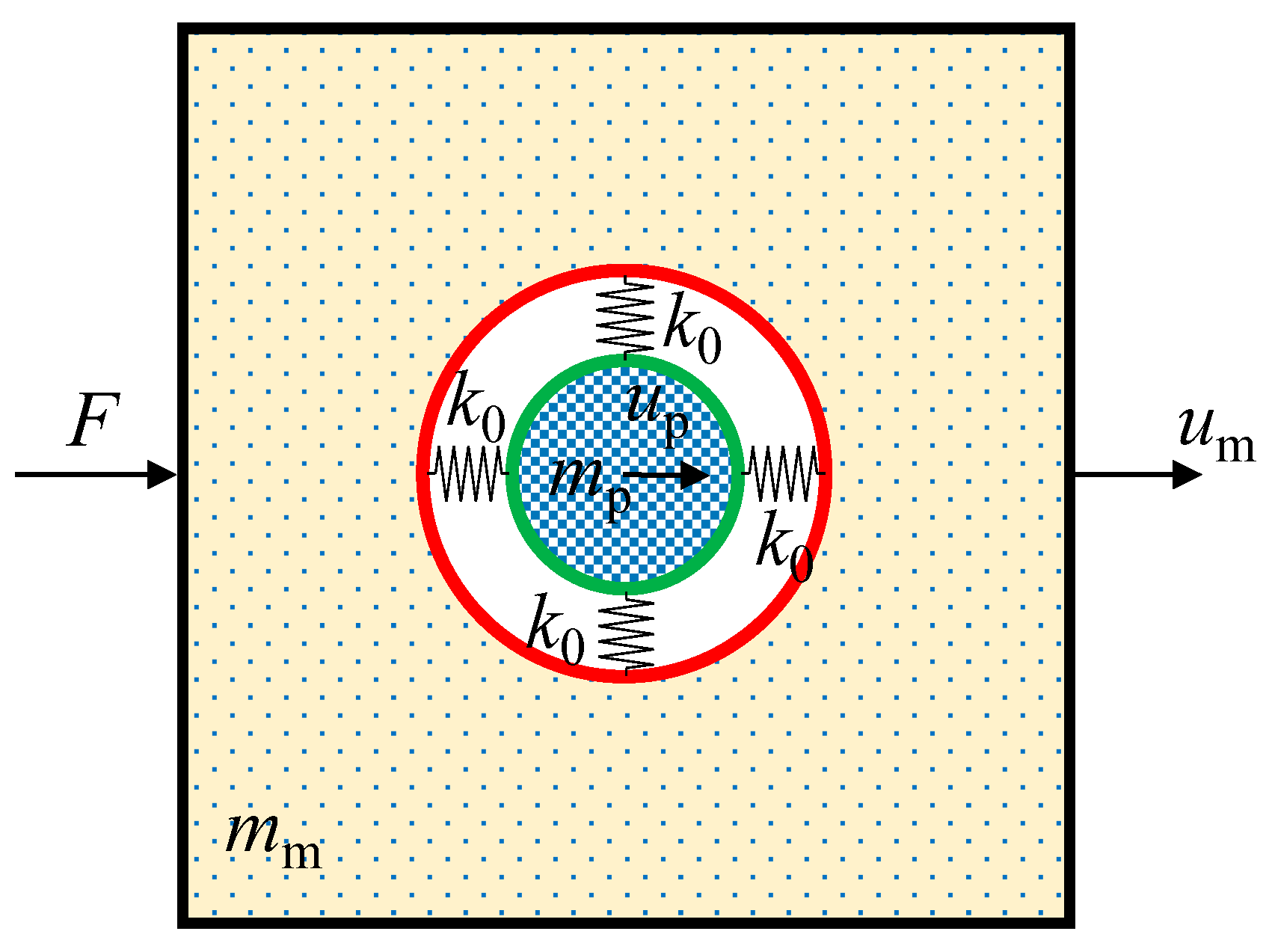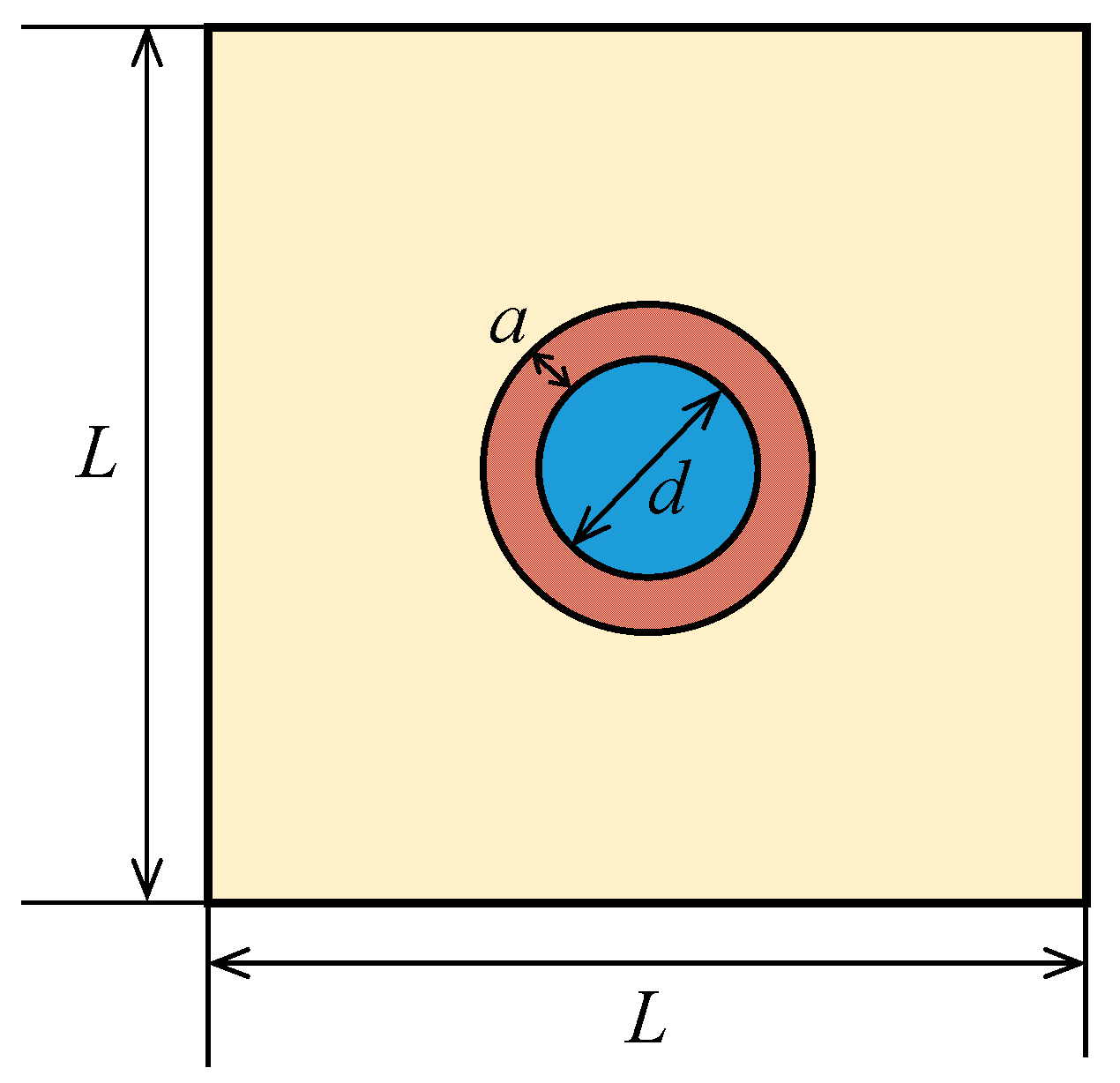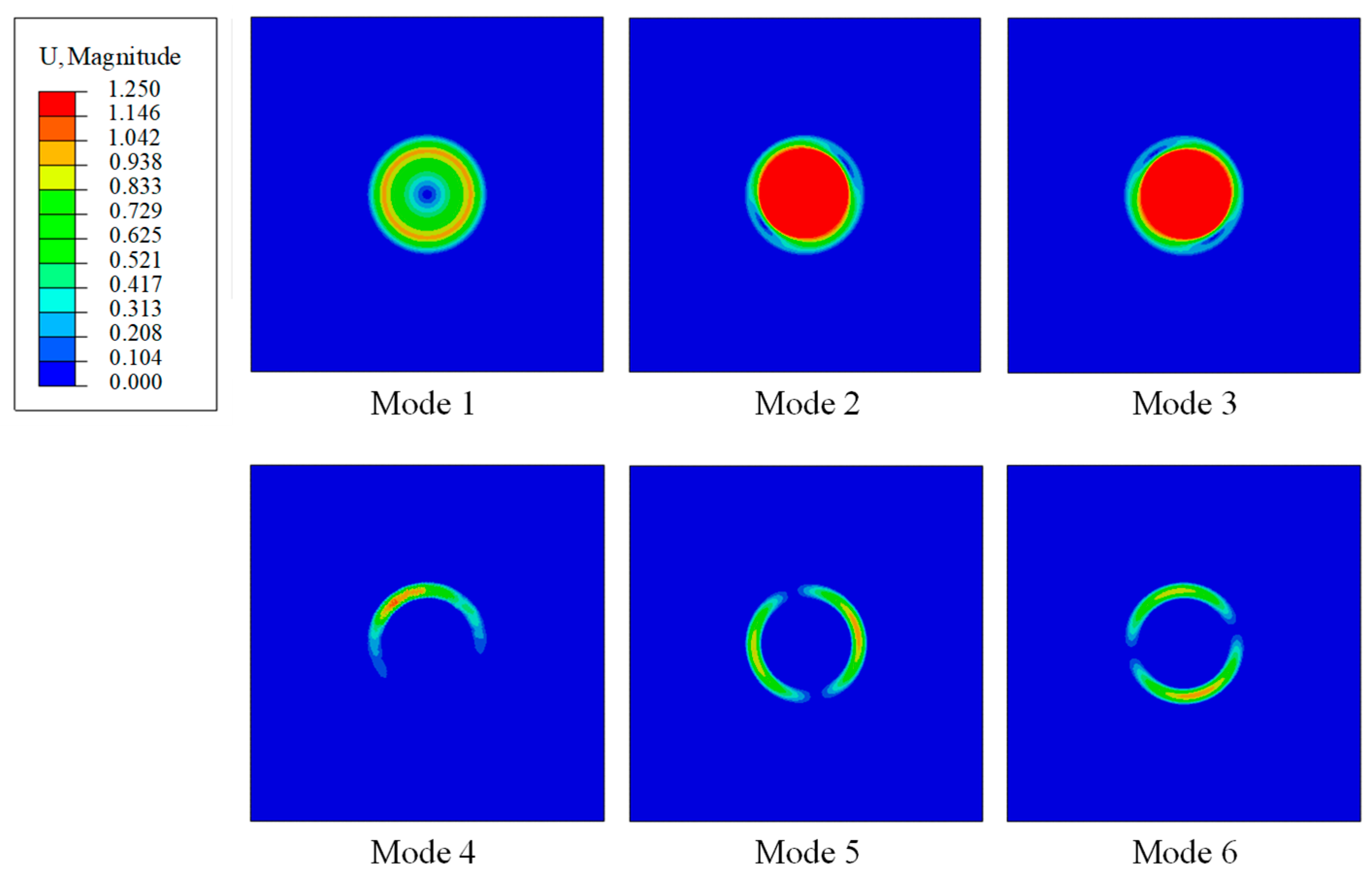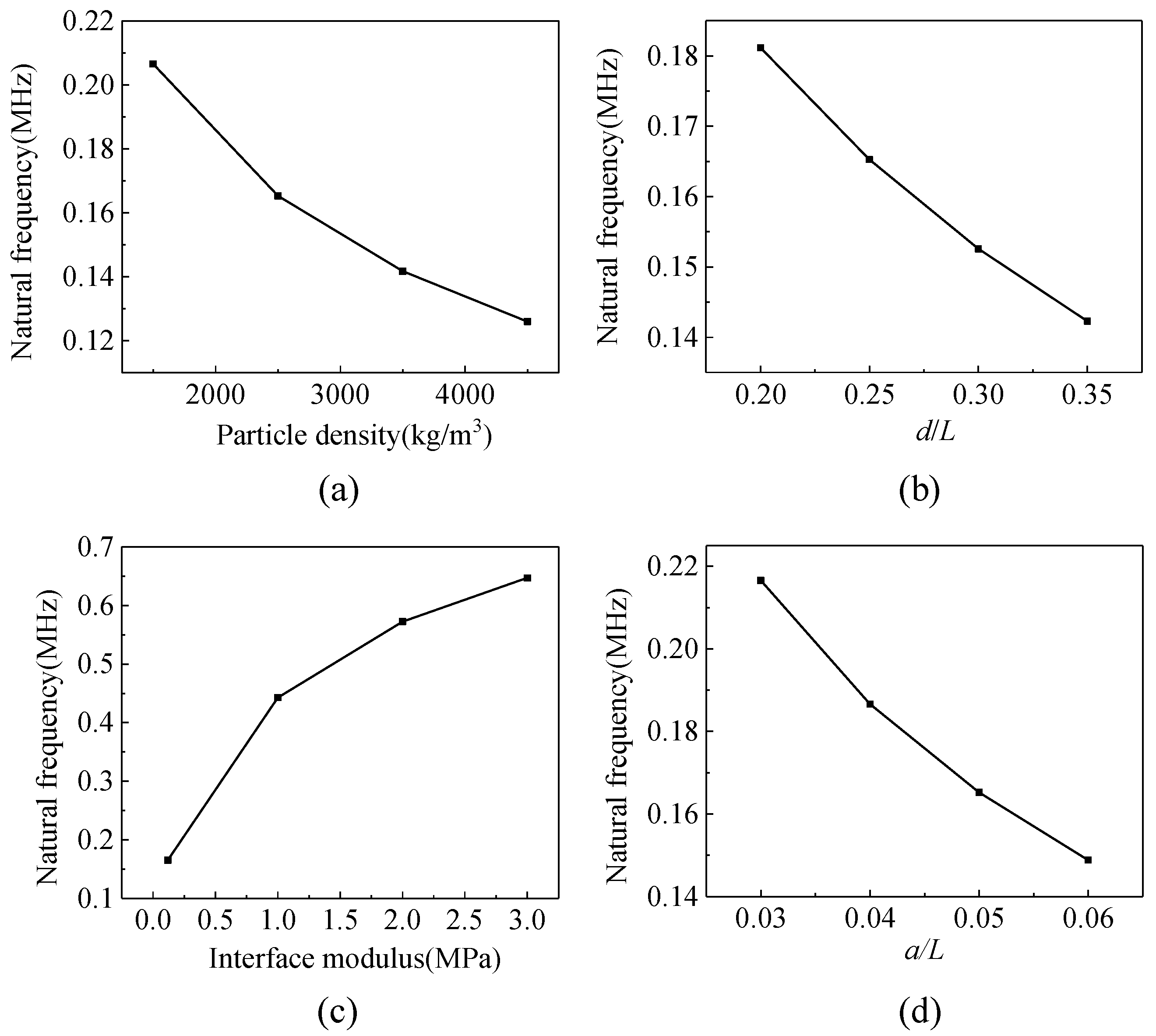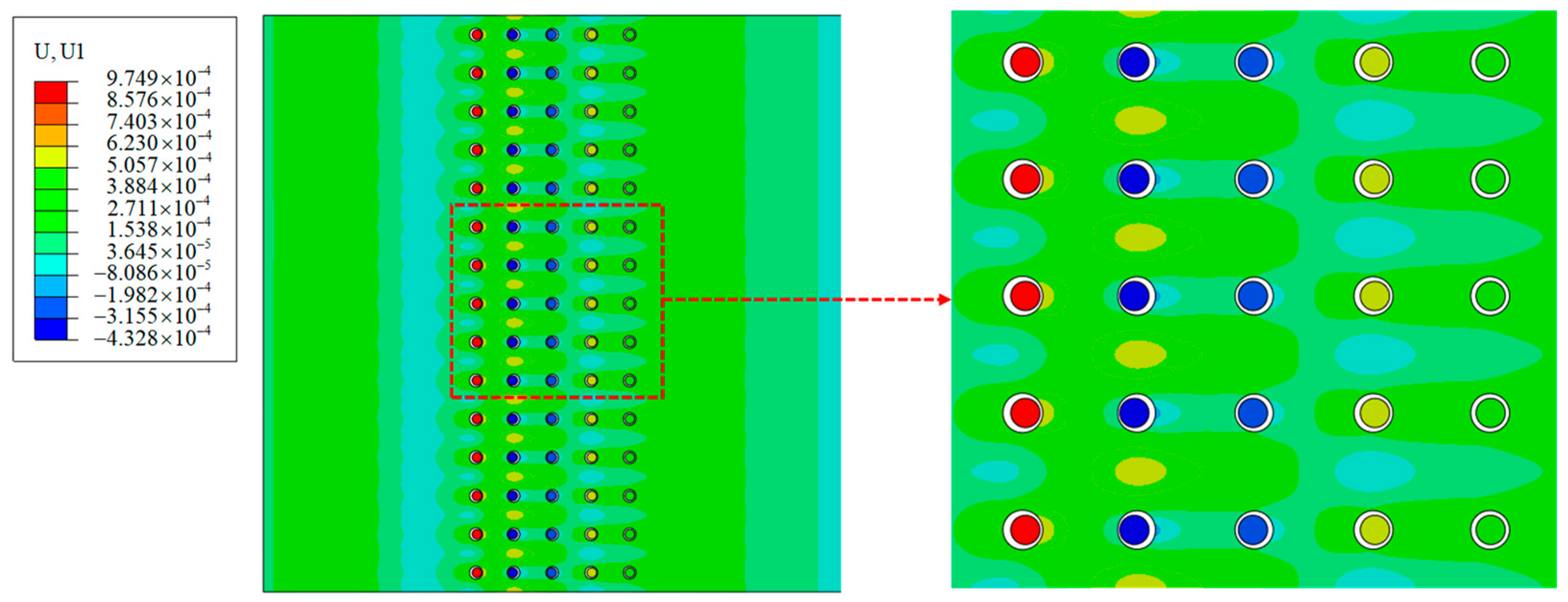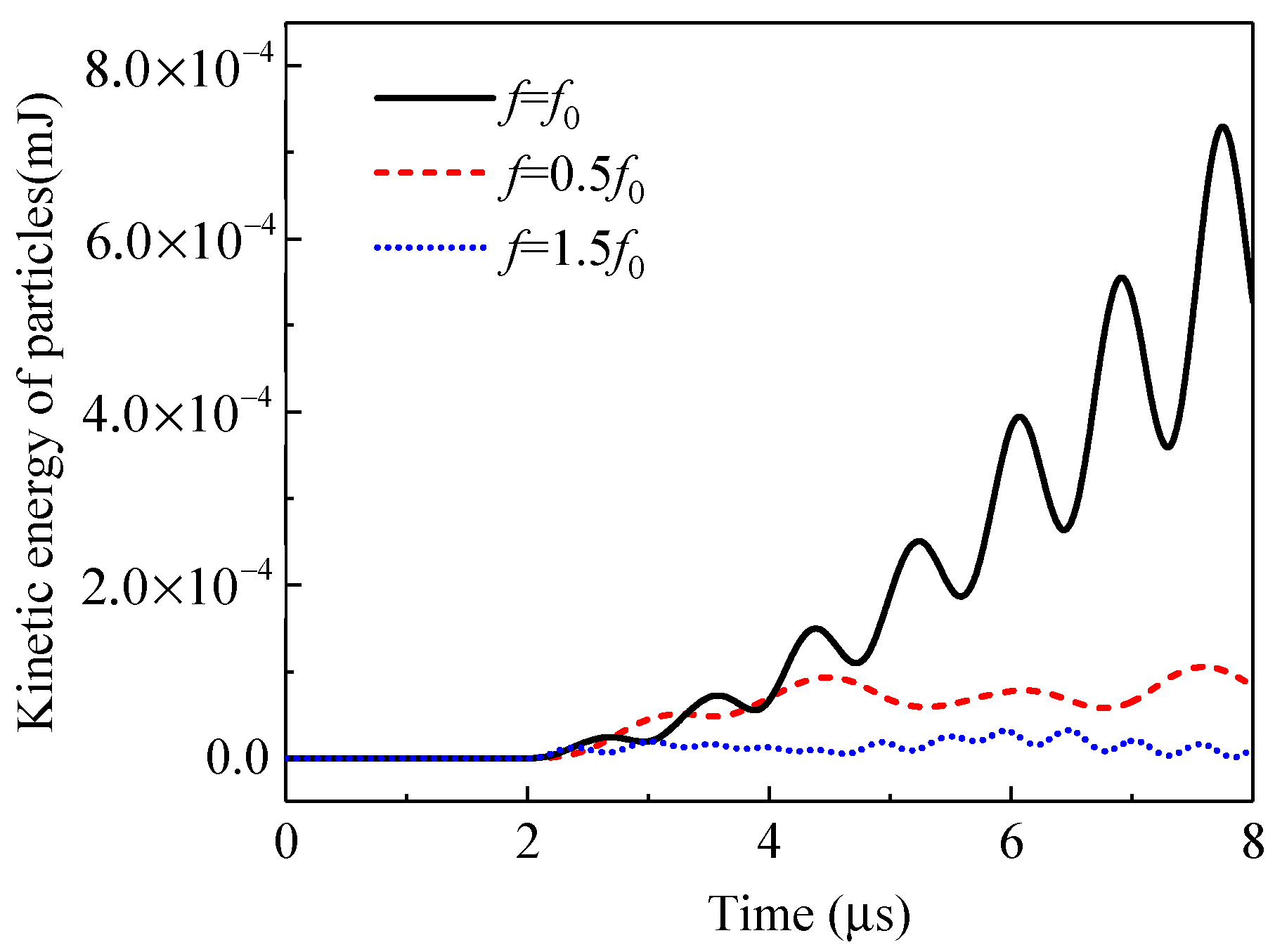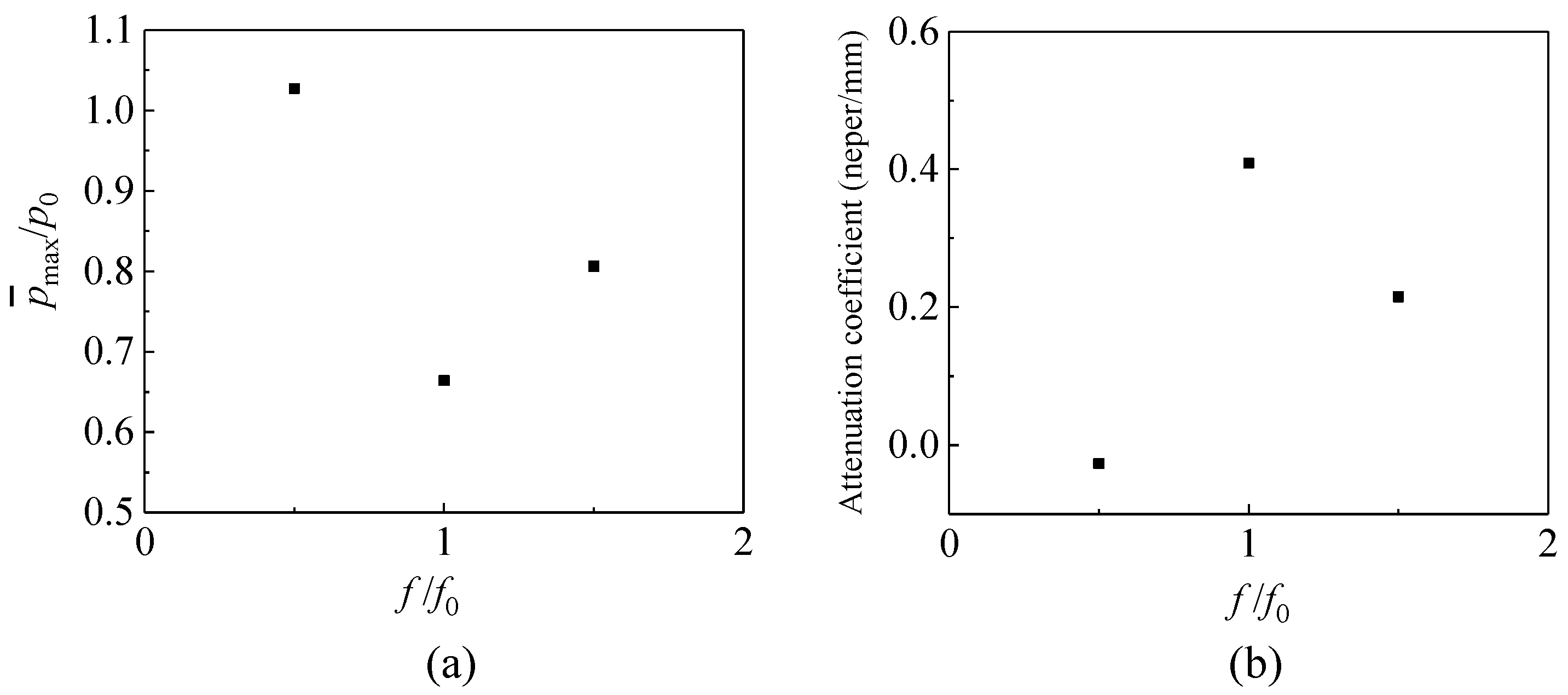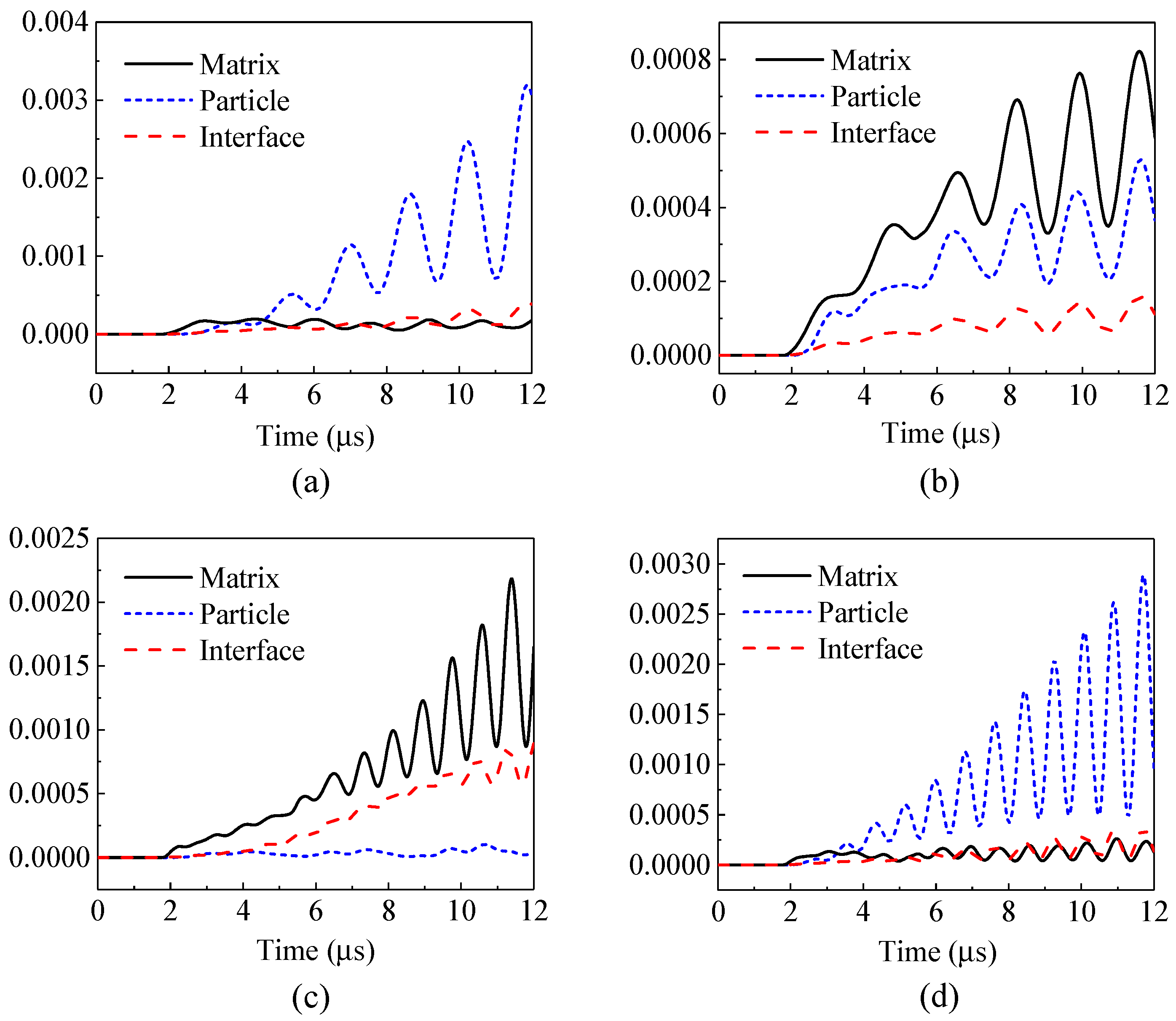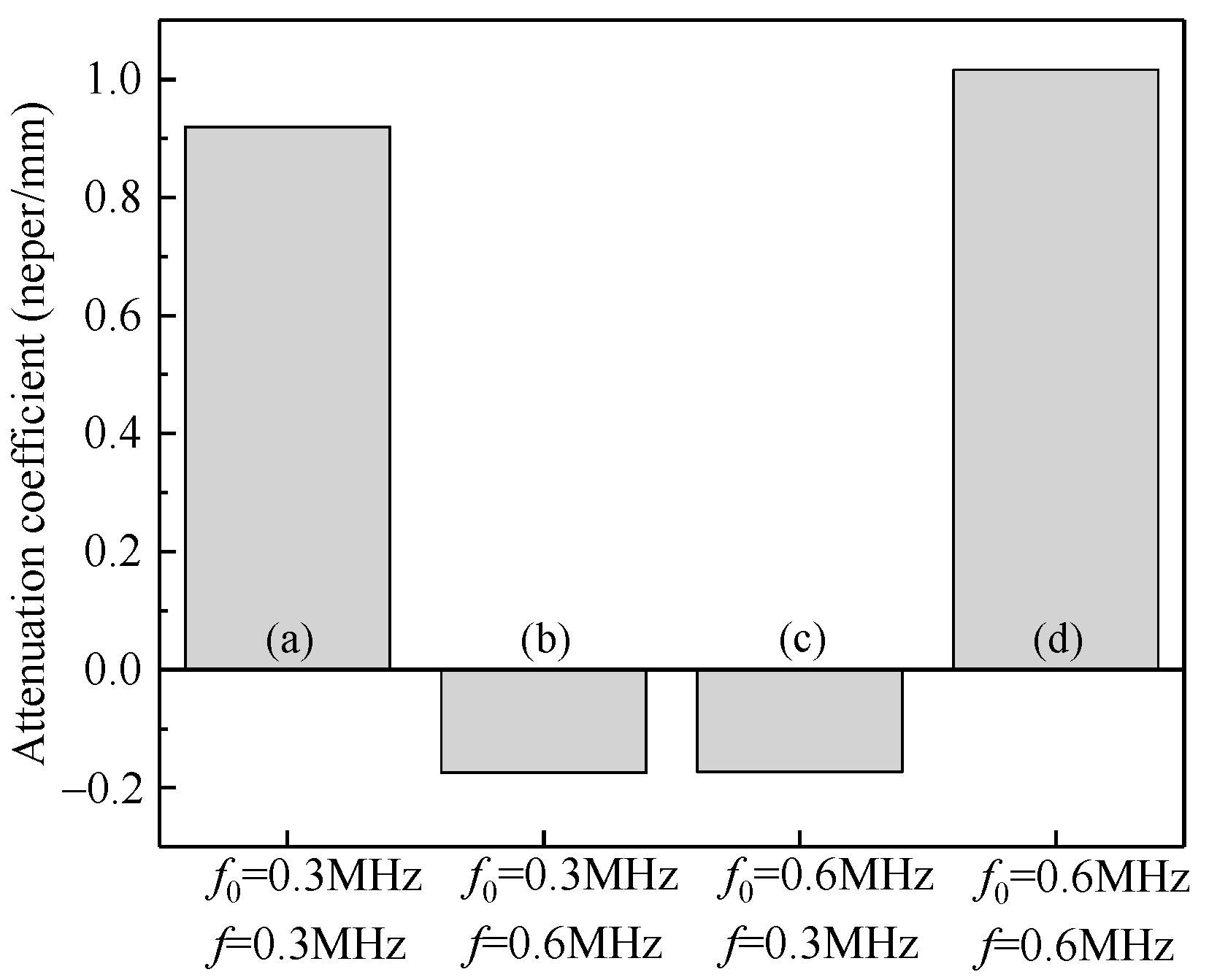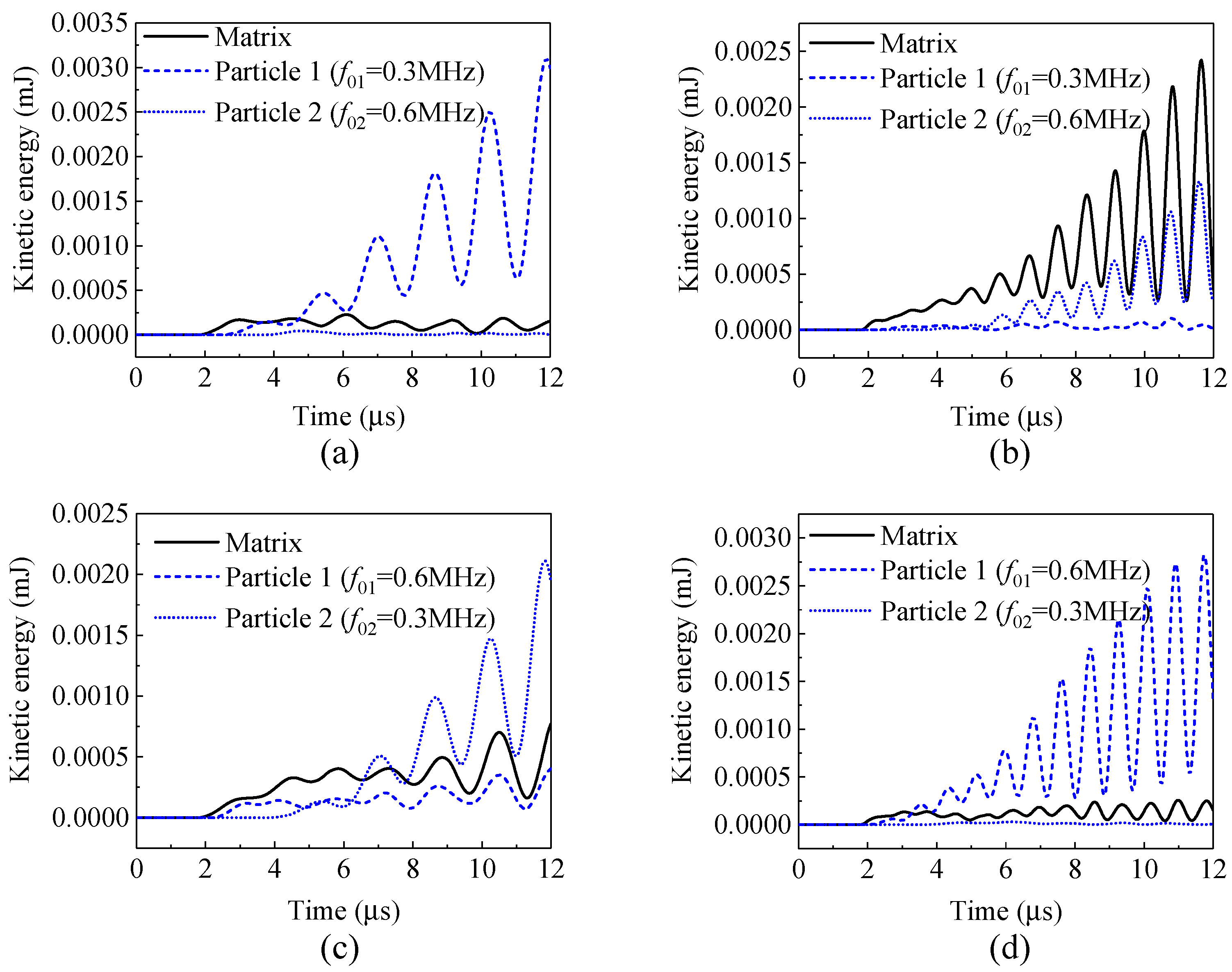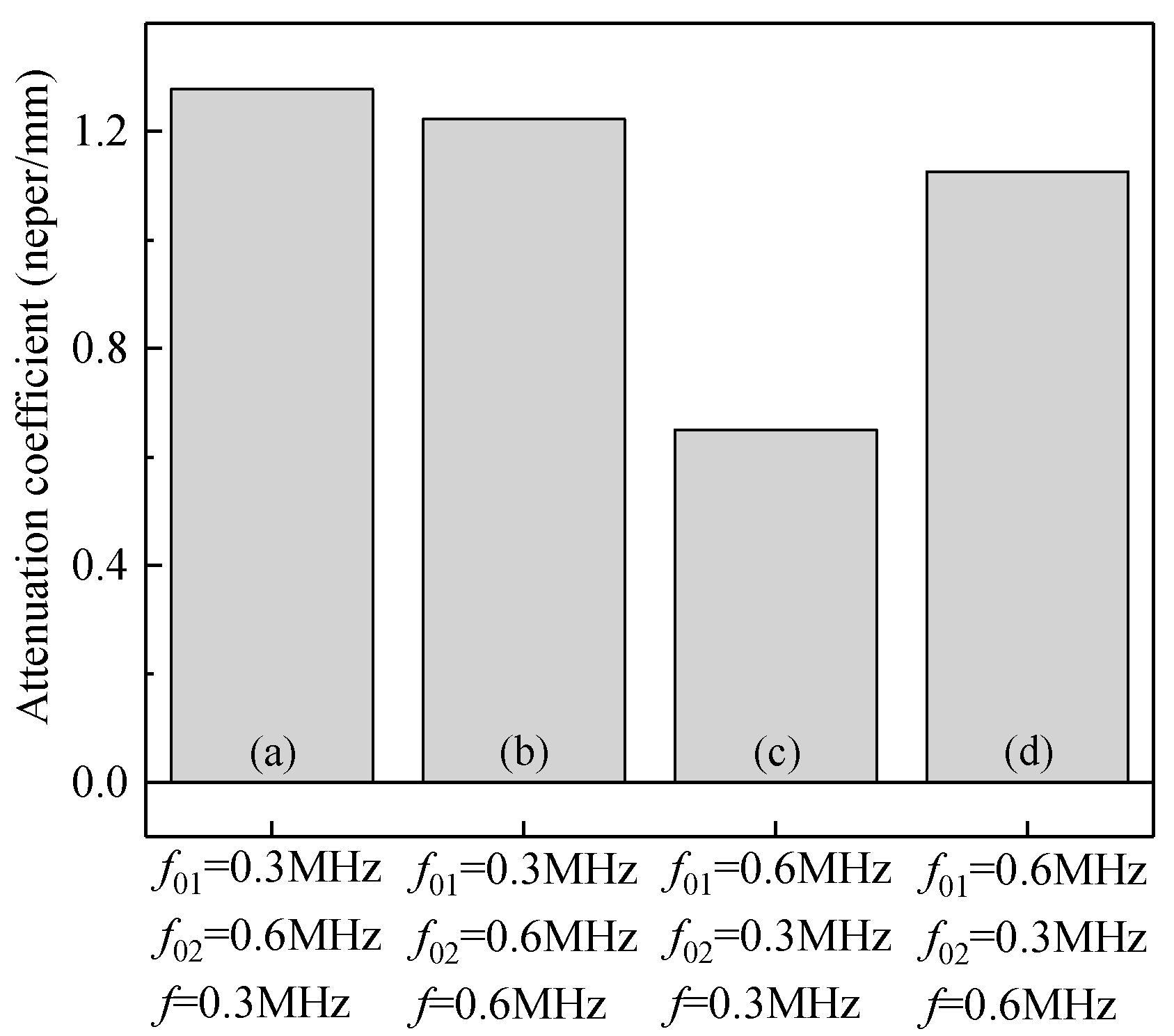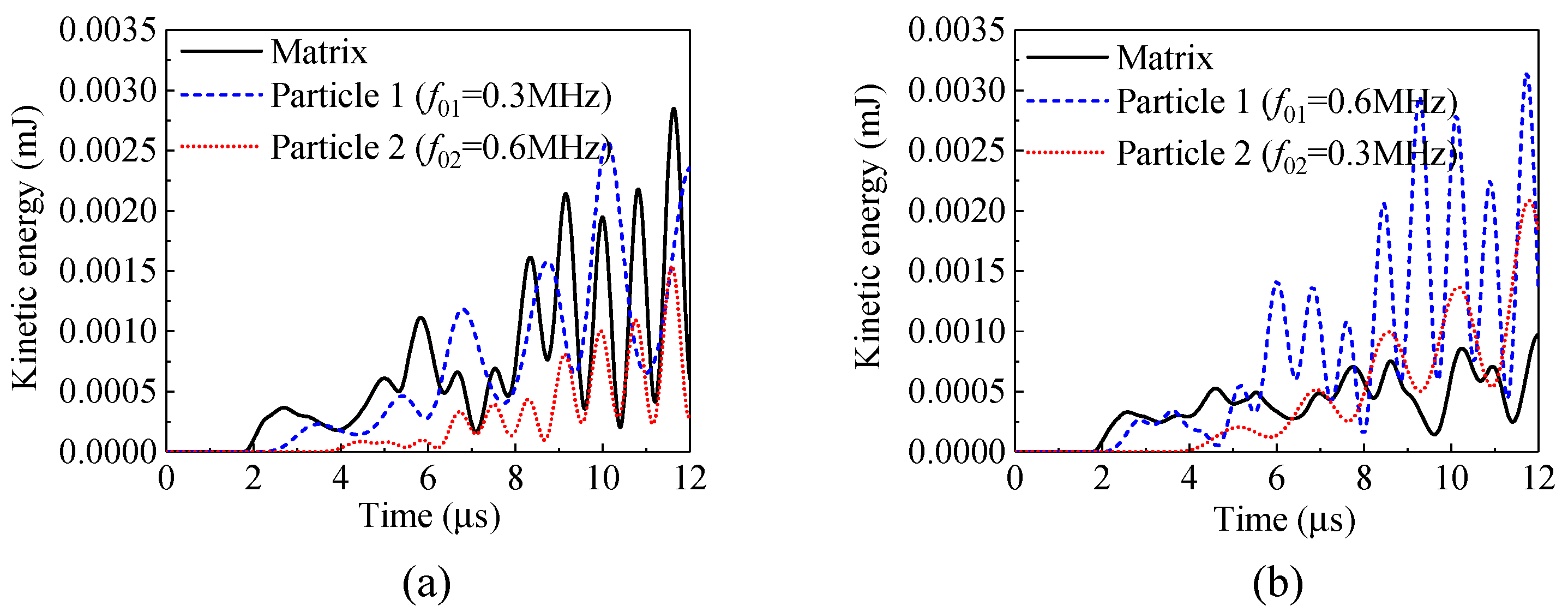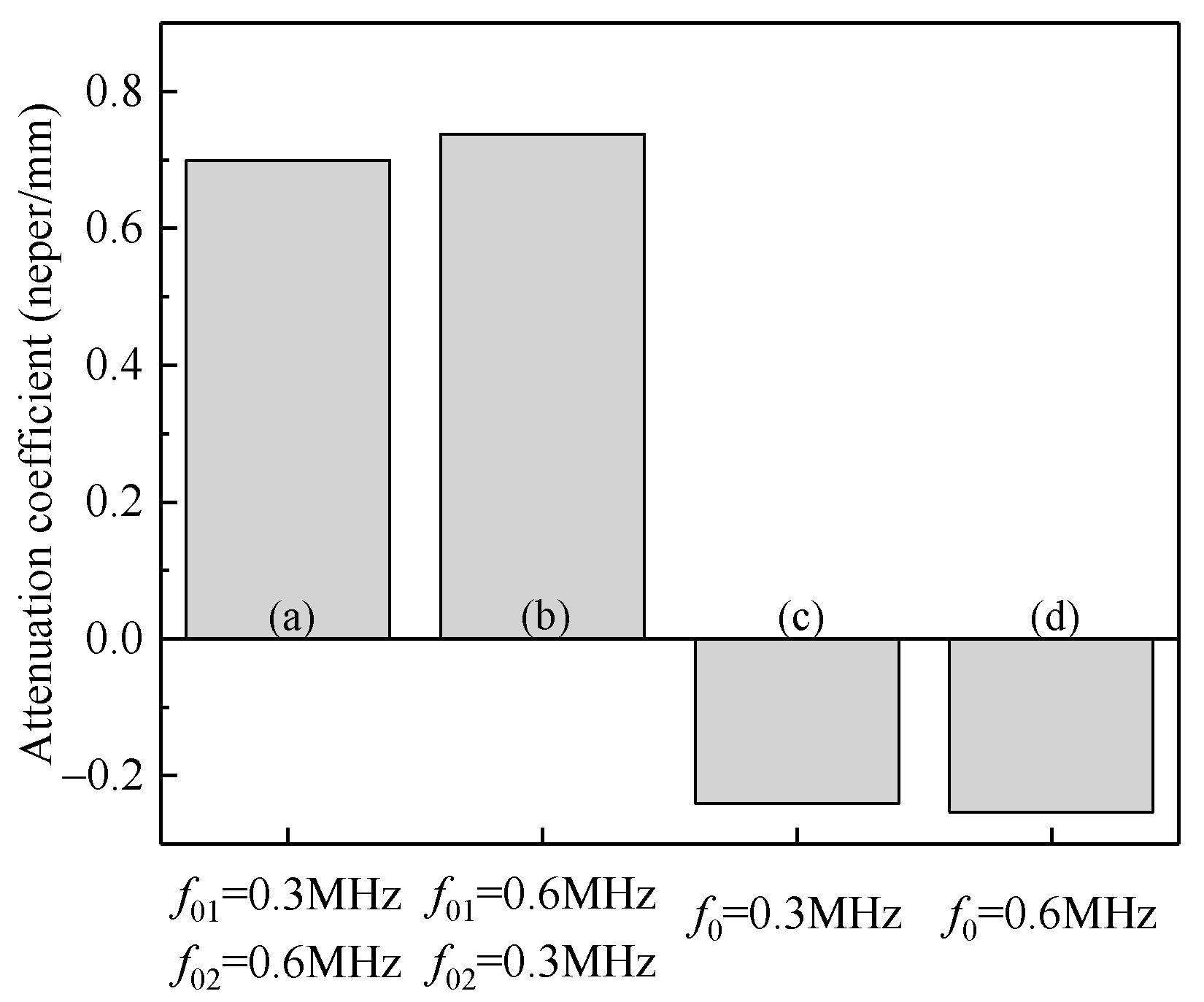1. Introduction
Energy localization is an effective approach to attenuate stress waves. By designing the microstructures in a material, a large amount of energy of the incident stress waves can be locally trapped in some specific parts of the material, and the energy stream that propagates forward is reduced, leading to a reduction in the amplitude of the stress wave. Local deformation, motion, or failure of the material may cause energy localization [
1]. Achieving the stress wave attenuation by promoting the local resonance of the microstructures of the composite is of great interests for the development of high-performance protection composite materials.
Concept of local resonance is widely used in the research on photonic crystals [
2,
3]. Liu et al. [
4] fabricated sonic crystals, based on the idea of localized resonant, the structure cell consists of the high-density solid core and elastic soft coating. The material preforms negative modulus at a certain frequency range. Such materials with negative elastic modulus belong to metamaterials [
5], which have physical properties that the natural materials do not possess due to special artificial design. It is found that the sonic crystals with local resonance structure have strong attenuation band gaps to the specific frequency of sound wave [
6]. Thus, the acoustic waves of some particular frequencies are unable to propagate through the sonic crystals. Dupont et al. [
7] presented a cubic array of thick spherical shells with holes in air, and observed a low frequency stop band of the acoustic wave.
The phenomenon of band gap and the design of metamaterials also exist in mechanical materials [
8,
9]. Li and Wang [
10] proposed a two-dimensional mechanical system containing one rigid body and several springs around it as an elastic metamaterial exhibiting both negative mass and negative modulus under specific frequencies. The local resonance mechanism is also used for elastic wave absorption [
11], vibration suppression [
12], and cloaking [
13]. Mitchell et al. [
14] proposed a type of concrete called metaconcrete for the attenuation of elastic waves induced by dynamic excitation. Kettenbeil and Ravichandran [
15] carried out experimental investigation of the dynamic behavior of metaconcrete, and found that the locally resonant metamaterial can attenuate the applied stress waves at the inclusion’s eigenfrequencies. Nouh et al. [
16] presented metamaterial plates with built-in local resonances consisting of a viscoelastic membrane and a small mass, and the plates are effective in attenuating and filtering low-frequency structural vibration.
The present work is performed based on the previous work for a deeper understanding of the mechanism of the stress wave attenuation by the addition of solid particles in a composite: a two-dimensional composite model with coated particles is setup in the finite element method (FEM) simulations and the effects of the properties of particles and coatings on the attenuation of stress wave are explored. The frequency of the stress wave in this paper is in the order of MHz, which is much larger than that in the previous studies (e.g., kHz). In addition, a novel study is performed on the composite that can simultaneously attenuate a combination of stress waves of different frequencies.
This paper is organized as follows: the natural frequency of the composite and its influence factors are discussed at first, and some theoretical and numerical work are introduced in
Section 2; the stress wave propagation in the composite is simulated, and the stress wave attenuation effect of the material is verified in
Section 3; the design of multi-frequency attenuation material is discussed in
Section 4. The conclusions are drawn in
Section 5.
4. Designed Composite for Multi-Frequencies Attenuation
Composite with uniform microstructures has only one natural frequency of Mode 2 (
Figure 3) and it is effective for the attenuation of the incident stress wave with similar frequency. Therefore, the frequency range of the stress waves that can be attenuated is quite limited. How to conquer this disadvantage and achieve the attenuation on a wide range of stress waves is discussed in this section.
In the numerical model shown in
Figure 10, the particles in the red rectangular box have the local natural frequency of
and the particles in the blue rectangular box have the local natural frequency of
. The natural frequencies of the local vibration modes are determined by adjusting the Young’s modulus of the coating:
E = 0.3 MPa for
and
E = 1.5 MPa for
. Incident stress waves with the frequencies of 0.3 MHz and 0.6 MHz are applied on the left-hand side boundary of the model.
First, the kinetic energies and the attenuation coefficients of the composites containing only a single local natural frequency of particles are shown in
Figure 11 and
Figure 12.
Figure 11 illustrates that when the frequency of the incident stress wave is the same as the natural frequency (e.g.,
Figure 11a:
f0 = 0.3 MHz,
f = 0.3 MHz, and
Figure 11d:
f0 = 0.6 MHz,
f = 0.6 MHz), the kinetic energies of the vibrating particles are dominant, indicating the occurrence of local resonance and a better performance of attenuation.
Figure 12 also confirms that the attenuation coefficients of the composite to the stress wave are larger in these two cases.
When the frequency of the incident stress wave deviates from the natural frequency of the system, e.g.,
Figure 11b:
f0 = 0.3 MHz,
f = 0.6 MHz, and
Figure 11c:
f0 = 0.6 MHz,
f = 0.3 MHz, the energy of the matrix is more dominant, and the composite exhibits no attenuation on the stress waves in these two cases, as shown in
Figure 12.
In the above simulations, each composite can significantly attenuate the incident stress wave of a specified frequency. In the following simulation results, by adjusting the Young’s modulus of the coating, the particles in the red and blue rectangular regions, as shown in
Figure 10, have different natural frequencies. The kinetic energies and attenuation coefficients are shown in
Figure 13 and
Figure 14, respectively. In the figures, Particle 1 represents the particles on the left-hand column, while Particle 2 represents the particles on the right-hand column. The natural frequencies of the two types of particles, i.e.,
f01 and
f02, are 0.3 MHz and 0.6 MHz, respectively, for the results shown in
Figure 13a,b, and 0.6 MHz and 0.3 MHz, respectively, for the results shown in
Figure 13c,d. Incident stress waves with the frequencies of 0.3 MHz and 0.6 MHz are applied separately on the left-hand side boundary of the model.
As shown in
Figure 13a, the kinetic energy of the particles with
f01 = 0.3 MHz is significantly higher than those of the matrix and the particles with
f02 = 0.6 MHz, because the frequency of the incident wave is the same as the natural frequency of the particles on the left-hand side, i.e.,
f =
f01 = 0.3 MHz, and the local resonance occurs to the particles with
f01 = 0.3 MHz. If the incident wave has the same frequency as the particles on the right-hand side, i.e.,
f =
f02 = 0.6 MHz, as shown in
Figure 13b, the kinetic energy of the particles with
f02 = 0.6 MHz is significantly higher than that of the particles with
f01 = 0.3 MHz, due to the local resonance of the particles with
f02 = 0.6 MHz. As can be seen from the attenuation coefficients for Cases (a) and (b) in
Figure 14, the composite embedded with the particles of two different natural frequencies can attenuate both the stress waves with the frequencies of 0.3 MHz and 0.6 MHz.
By switching the natural frequencies for the two types of particles in the red and blue boxes (
Figure 10), i.e.,
f01 = 0.6 MHz and
f02 = 0.3 MHz, similar attenuation behaviors are observed: larger kinetic energies are obtained for the particles with the natural frequency equal to the frequency of incident stress wave, as shown in
Figure 13c,d. The attenuation coefficients for Cases (c) and (d) provided in
Figure 14 also confirm this attenuation effect.
In the above study, structures containing particles with two different natural frequencies have attenuation effect on both incident waves when each wave is separately loaded. However, most of the excitations are broad-banded in practice. Thus, in the study, incident stress waves with two frequencies (
f = 0.3 MHz,
f = 0.6 MHz) are introduced at the same time, and the model is the same as that in
Figure 10. As can be seen from the kinetic energies of the matrix and particles in
Figure 15, in the two different samples, the kinetic energies of the particles are both significant, indicating that the local resonance of particles are inspired.
In terms of the attenuation coefficient as shown in
Figure 16, the attenuation effect on the stress waves through local resonance is also obtained. It can be seen that different particle arrangements have little influence on the attenuation coefficient. By contrast, if there is only one type of particles presented in the matrix, the amplitude of the stress wave is not attenuated, although local resonance can occur, because the stress wave with another frequency can still propagate through the composite. Therefore, to attenuate a wide band of stress waves, a corresponding distribution of the natural frequencies of particles is required. A variety of stress waves are attenuated by adding a variety of particles to the composite.
5. Conclusions
The local resonant attenuation of stress wave in particulate composites is discussed in this work. The coated particles are uniformly distributed inside the composite. The local vibration mode and the natural frequency of the particles are studied numerically. The effects of particle diameter, density, Young’s modulus and the thickness of the coating layer on the natural frequency are examined.
Previous studies focused on the stress waves with low frequencies in the order of kHz, while higher frequencies of stress waves propagating through a particulate composite are investigated in the present work. The mechanism of the stress wave attenuation by adding solid particles is revealed. When the frequency of the excitation is close to the natural frequency associated with the local vibration mode, the local resonance of the particles is agitated. As a result, a large amount of the incident energy transforms to the kinetic energy of the particles, which is thereafter dissipated in the process of the strong particle oscillation.
The FEM simulations show that a particulate composite exhibits a much better attenuation performance for the stress wave, which has the frequency close to the natural frequency of the particles. It is also demonstrated that the attenuation for the incident stress waves with a broad distribution of frequencies can be achieved by introducing particles with various local natural frequencies in a composite.
